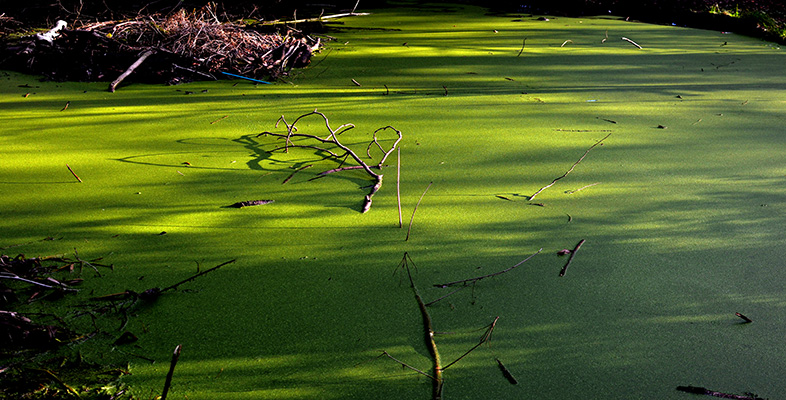1 Introduction
1.1 Origin of the term ‘eutrophication’
The levels of nutrients present determine the trophic state of a water body, where trophic means ‘feeding’.
SAQ 1
Give another example of the adjective trophic being used in a scientific context.
Answer
Trophic levels, as applied to a food chain.
The adjective eutrophe (literally ‘well fed’) was first used by the German botanist Weber in 1907, to describe the initially high nutrient conditions that occur in some types of ecosystem at the start of secondary succession. Scientists studying lakes at the beginning of the 20th century identified stages in plant community succession that appeared to be directly related to trophic state or nutrient status. They described a series of stages:
‘oligotrophic — mesotrophic — eutrophic — hypertrophic’
where oligotrophic meant ‘low in nutrients’, mesotrophic ‘with intermediate nutrient concentration’, eutrophic ‘high in nutrients’ and hypertrophic ‘very high in nutrients’. At the time, these definitions were derived from comparative estimates between water bodies with different nutrient status, judged according to their phytoplankton communities. Phytoplankton is a collective term for the free-floating photosynthetic organisms within the water column. It encompasses both algae (from the kingdom Protoctista) and photosynthetic members of the kingdom Bacteria. Thus an oligotrophic lake would have clear water with little phytoplankton, whereas a eutrophic lake would be more turbid and green from dense phytoplankton growth, and a mesotrophic lake would be intermediate between the two. Table 1.1 summarizes some of the general characteristics of oligotrophic and eutrophic lakes. A further definition, dystrophic, describes ‘brown-water lakes’, which have heavily stained water due to large amounts of organic matter usually leached from peat soils. The presence of these organic compounds can reduce the availability of nutrients to organisms, making the water body even less productive than an oligotrophic one.
| Characteristic | Oligotrophic | Eutrophic |
|---|---|---|
| primary production | low | high |
| diversity of primary producers | high species diversity,with low population densities | low species diversity,with high population densities |
| light penetration into water column | high | low |
| toxic blooms | rare | frequent |
| plant nutrient availability | low | high |
| animal production | low | high |
| oxygen status of surfacewater | high | low |
| fish | salmonid fish (e.g.trout, char)often dominant | coarse fish (e.g. perch, roach, carp) often dominant |
SAQ 2
Why is light penetration poor in eutrophic lakes?
Answer
The high density of phytoplankton absorbs light for photosynthesis and prevents it penetrating deeper into the water.
More recently, trophic bands have been defined in relation to levels of nutrients measured by chemical analysis. Table 1.2 shows trophic bands as defined in relation to concentrations of total phosphorus.
| Trophic band | Total phosphorus/mg l-1 |
|---|---|
| dystrophic | |
| oligotrophic | 0.005-0.01 |
| mesotrophic | 0.01-0.03 |
| eutrophic | 0.03-0.1 |
| hypertrophic | >0.1 |
The trophic state of water bodies and rivers varies depending on a number of factors, including position in the landscape and management of surrounding land. In general, upland areas are more likely to have nutrient-poor (oligotrophic) water, characterized by relatively fast-flowing rivers (Figure 1.1) and lakes that have clear water with limited higher plant communities.
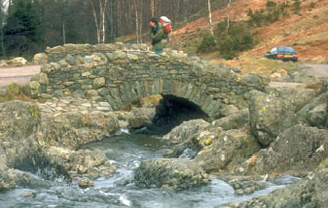
By contrast, lowland waters in more fertile river catchments tend to be nutrient-rich (eutrophic), and lakes in lowland areas are more likely to be turbid with lush fringing vegetation. Lowland rivers have slower flow and are likely to be more nutrient rich as a result of soluble compounds having been washed into them. They are likely to have fringing vegetation and some floating and submerged aquatic plants (Figures 1.2 and 1.3). In aquatic systems, the term macrophyte is used to describe any large plant (macro, large; phyte, plant). The term is used to distinguish angiosperms (whether emergent, floating or submerged) from small algae such as diatoms (which are strictly not plants at all, but are often lumped together with plants when considering the productivity of ecosystems).
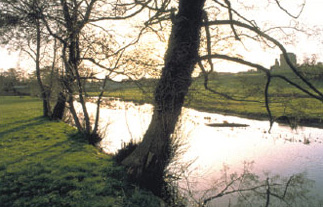
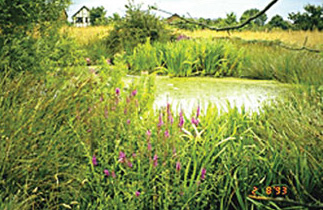
SAQ 3
What is the process by which nutrient elements are lost from the soil profile by the action of excess rainfall draining through it, which may eventually deliver them to a surface water body?
Answer
Leaching.
The term ‘eutrophication’ came into common usage from the 1940s onwards, when it was realized that, over a period of years, plant nutrients derived from industrial activity and agriculture had caused changes in water quality and the biological character of water bodies. In England and Wales, eutrophication has been a particular concern since the late 1980s, when public awareness of the problem was heightened by widespread toxic blue-green bacterial blooms (commonly, but incorrectly, referred to as algal blooms) in standing and slow-flowing freshwaters. Figure 1.4 shows blue-green bacteria (cyanobacteria) growing at the margins of a lake. Cyanobacteria are not typical bacteria, not only because some of them are photosynthetic, but also because some of them can be multicellular, forming long chains of cells. Nonetheless, cyanobacteria clearly belong to the kingdom Bacteria because of their internal cellular structure.
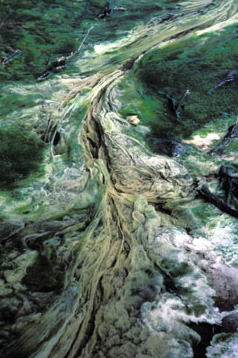
SAQ 4
Why are cyanobacteria so productive in eutrophic water bodies (Figure 1.4) compared with oligotrophic ones?
Answer
The ready availability of nutrients allows rapid growth. In oligotrophic water the rate of growth is limited by the nutrient supply, but in eutrophic water it is often only the availability of light which regulates primary production.
